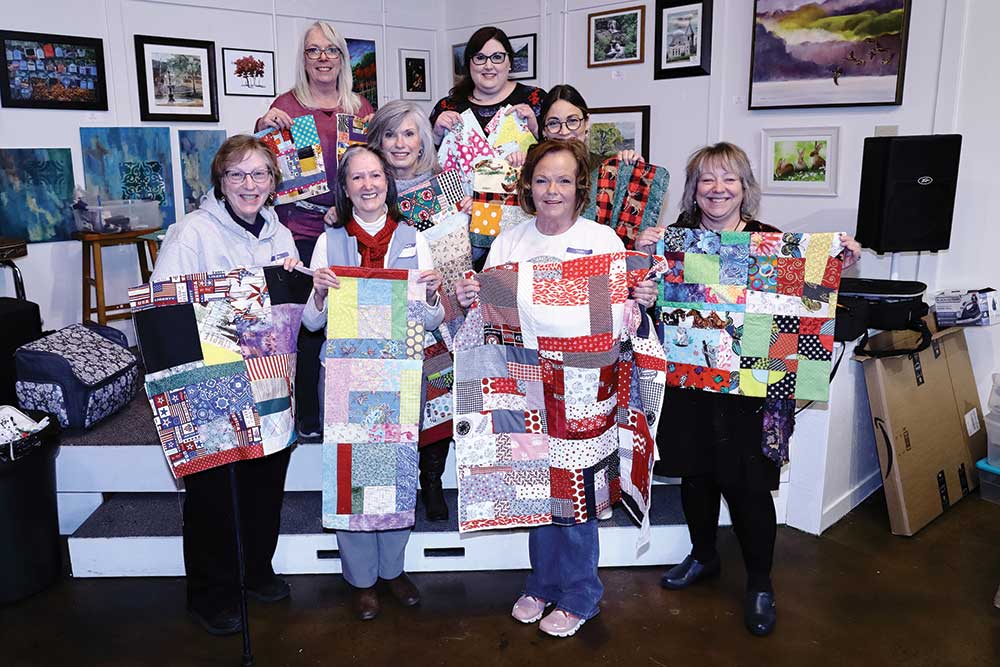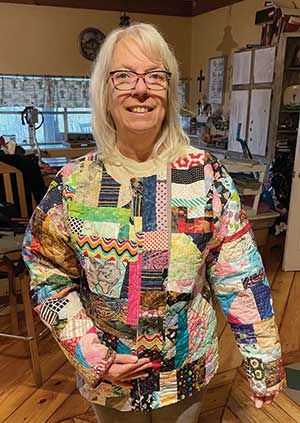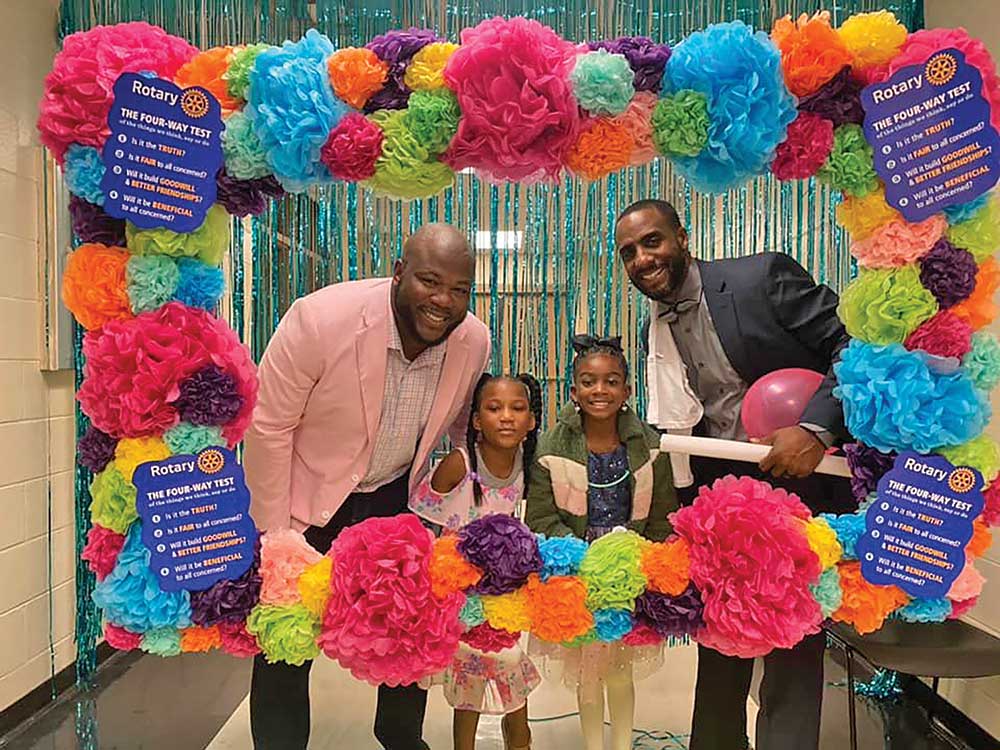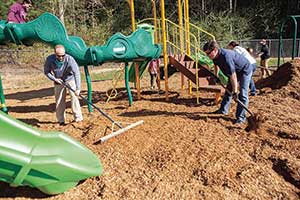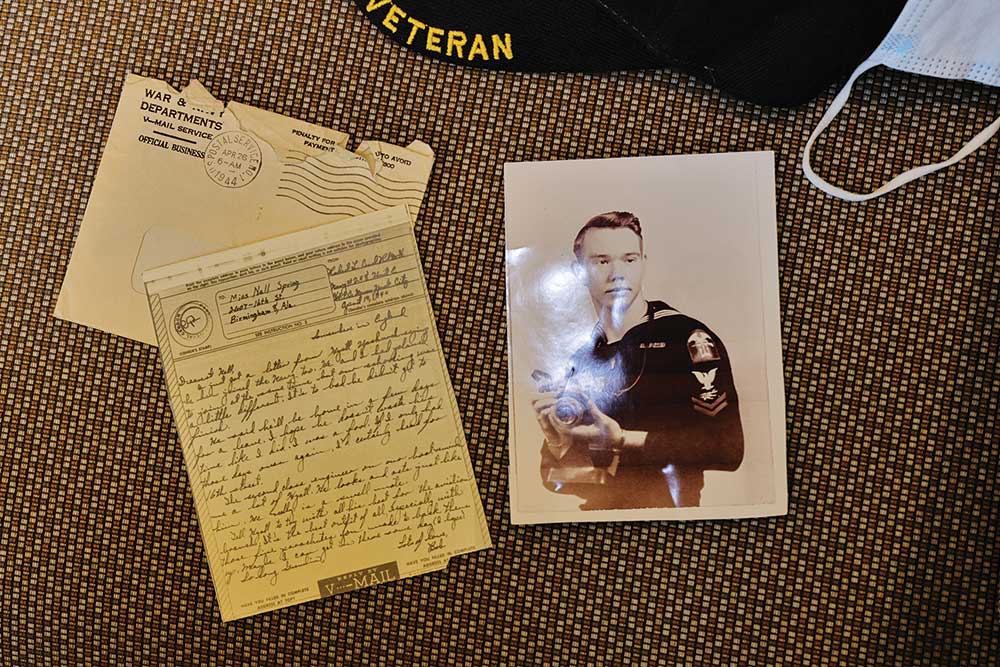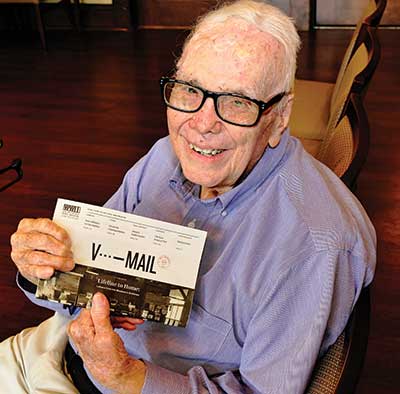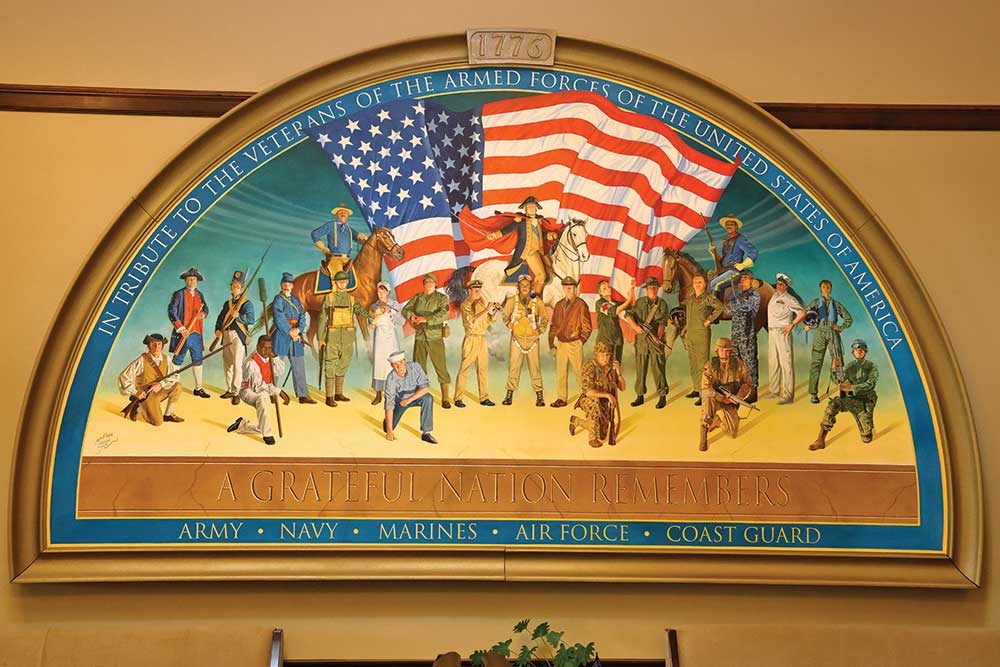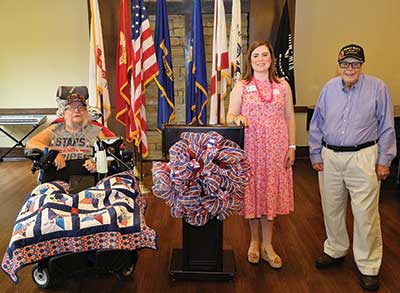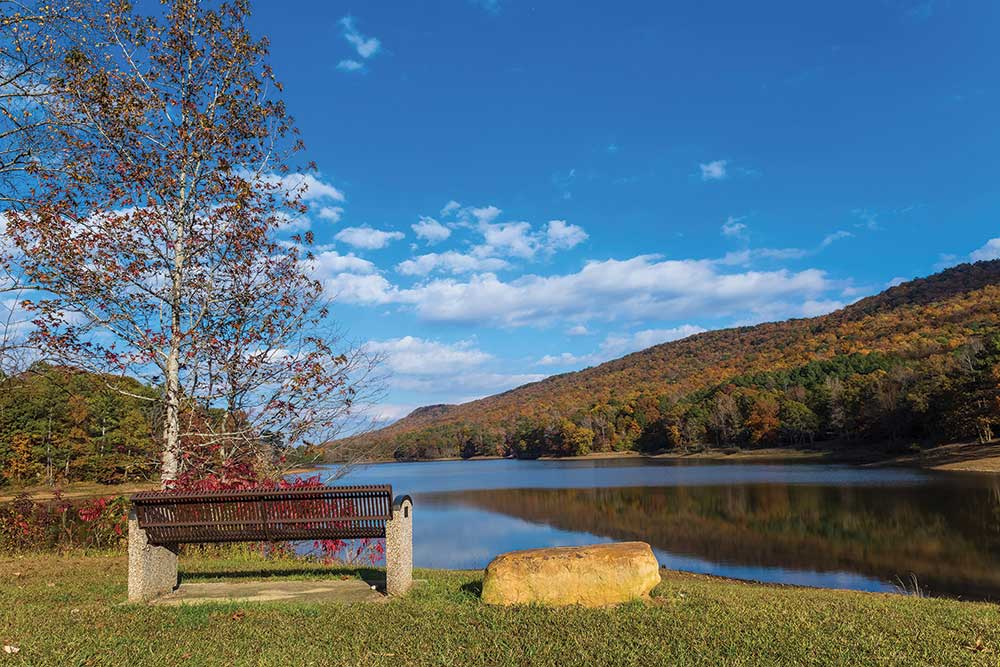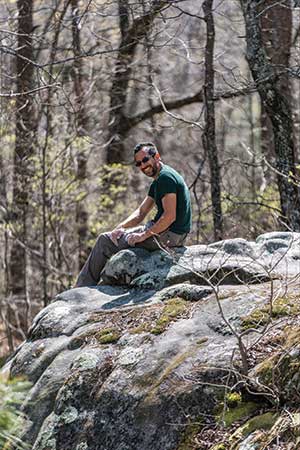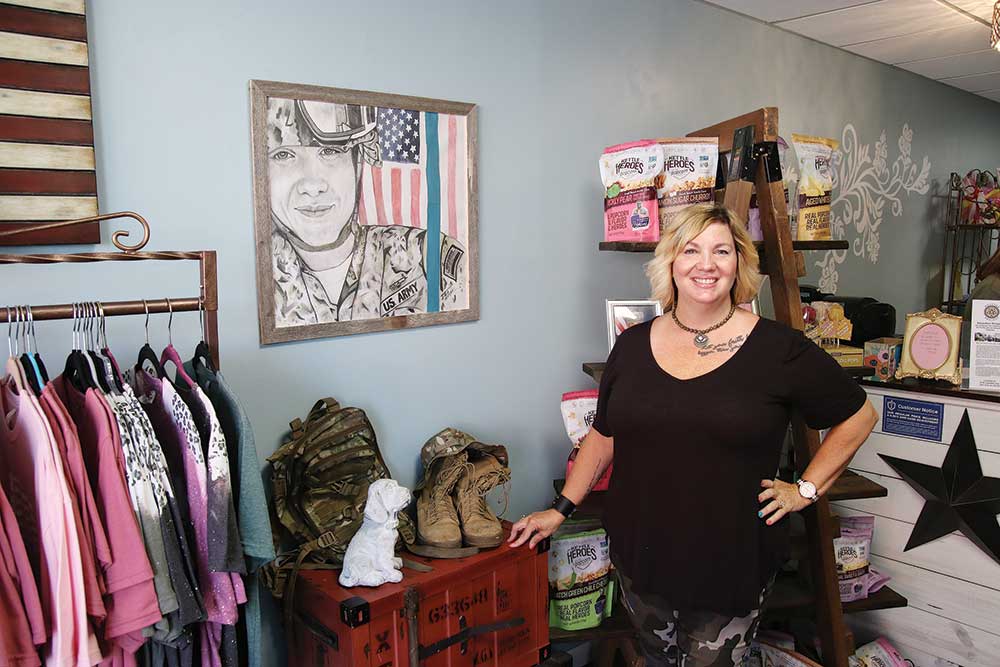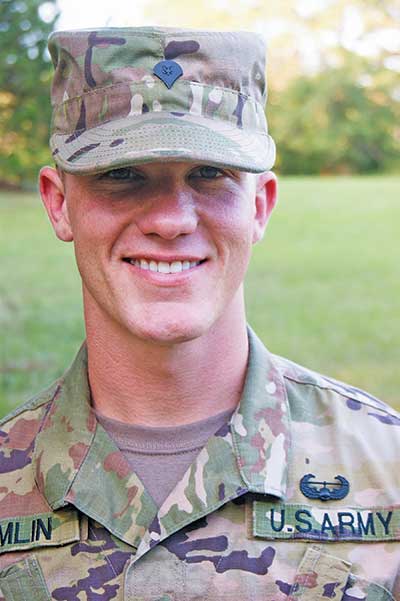Tracy Rybka turns old clothes into heirloom quilts
Story by Elaine Hobson Miller
Photos by Richard Rybka
You might call Tracey Rybka a “memory preservationist.” She turns old shirts, used quilts, scruffy housecoats and fabric scraps into quilts that preserve memories of the people who wore or used those original items. She calls them T-shirt and memory quilts. Her customers call them wonderful.
“My dad always wore overalls,” says Vicki Buckner of Springville, a happy Tracey’s Stitches & Designs client. “When he passed away in 2020, I took his overalls to Tracey, and she made miniature overalls for 20 teddy bears. I gave those bears to my nieces and nephews – his grandchildren – for Christmas that year, and they loved them. All of them are in their 20s and 30s, and they say they bring back lots of memories of their grandfather. Tracey did a wonderful job.”
Tracey has been sewing since she was a child. Her first project was a skirt for 4-H Club, and her first quilt was for her own granddaughter. “My mother sewed and quilted, and she has quilts all over the world,” Tracey says. “Almost 10 years ago, my daughter went through some fertility issues. After five years, she and her husband gave up, then she got pregnant. I wanted to do something special to honor my mom and my new granddaughter, so I made a baby quilt. I was hooked.”
Between them, she and her husband, Richard, have five children, seven grandchildren and one great-grandchild. Tracey has made quilts for all but a couple of those descendants. “I watched YouTube and read quilt magazines,” she says. “I still do. I probably have 50 magazines.” She keeps several projects going at the same time and estimates she has made 50-60 quilts in the past 10 years. “The majority have been memory quilts and T-shirt quilts,” she says.
Her sewing room in her Springville home contains boxes of fleece, rolls and bags of batting, plastic see-through bins of zippers, threads and fabric scraps. Three clothes racks are draped with WIPs (works in progress), including quilts and some finished Christmas stockings. Several fabric animals watch from atop the bins, awaiting their final touches. She makes dogs, bears and bunnies from the same basic pattern, changing the length of their ears for the various species.
Often doing her hand work in a chair draped with the first adult quilt she made, she has a 10-foot long-arm machine nearby for the quilting process. Originally, she quilted on her mother’s long-arm, a 1950 Singer A1 built for use in a sweatshop. “I used it my first four to five years, but it got hard to find parts for it,” she says. “So, I bought another used one.” She in fact has two working long-arms – her mom’s being disassembled and packed away.
She works from home Mondays and Tuesdays from 8 a.m. until 8 p.m., teaches sewing classes for all ages on Wednesdays at Sewing Machine Mart in Springville, then heads to Mentone with Richard, a photographer. They stay through Sundays, working from her shop from 8 a.m. until 5 p.m. Tracey opened the shop Aug. 1 and teaches classes there on Saturdays. She and Richard hope to buy land and move to Mentone someday. For now, they have a camper on leased land.
“We fell in love with Mentone 20 years ago,” she says. “It has a touristy, creative atmosphere.” Her shop is in a 115-year-old school building, formerly Moon Lake Elementary School, that has been turned into Moon Lake Village. Rooms are rented to artisans such as Tracey. “We have the fourth-grade classroom,” she says.
In her Springville classes she has taught 9- and 10-year-old Girl Scouts from Trussville, and her eight-year-old granddaughter is getting private lessons at Tracey’s home. “Mine are one-day classes lasting two to five hours each, and the students walk away with a finished project, such as 2-by-2-foot scrappy quilts, pillow cases and zipper bags,” Tracey says. “I usually furnish them a kit with all the materials they’ll need.”
While she orders most of her fabric online because of quality issues, choices, and the ease of getting it – not to mention wholesale pricing – some of her best work has been from scraps. “I save everything,” she says. “I make scrappy-fabric wall hangings from old sheets and pillowcases, stained shirts and torn jeans.”
An example of a “landscape quilt” hangs on a wall of her shop. Another WIP, it is a farm scene with a red truck, ducks, a barn and a house. She cuts wavy strips of fabric for the mountains in the background and the fields in the forefront. “I sold one last year with a swing made of fabric and jute that actually moved,” she says.
She encourages her students to use whatever materials they have on hand. “A quilt backing can be an old sheet, or you can make a quilt reversible with scraps on both sides,” she explains. “Then you just have to buy the batting. Actually, you don’t really need batting if the fabric is thick enough.” Although she pieces her quilts together on a sewing machine, she has no issues with those who prefer to do it by hand. “I’m not the quilting police,” she tells her students.
Dubbing her scrap-method “up-cycling,” she took a king-size quilt with holes and stains, cut all of that out, and made baby quilts, lap quilts, diaper bags and pillows. “That carried on the memories of that quilt,” she says. She has made jackets and vests from old quilts, too. “So, you don’t have enough tees or whatever to make a quilt? Add fabric,” she teaches.
Her T-shirt quilts are made primarily from kids’ tees and sports tees. The memory quilts are made from shirts, gowns and housecoats, overalls, blue jeans, baby clothes and just about any other type of clothing. “I’m working on T-shirt quilt now with a little boy’s leather vest in it,” she says. “The vest is a tiny thing. The boy is now in college, and his mom is having it done as a Christmas gift.”
She also makes cork wallets and purses. “I learned about cork on YouTube,” she says. “Thecork is grown in Portugal, where cork oak trees are stripped, and the best bark is used for wine stoppers. The remainder is graded for other uses.”
According to an online article on cork fabric, the outer section of the tree bark is harvested with axes, not machines, then peeled back to reveal the cork layer. The cork is laid out to dry for six months, then boiled in water, flattened and molded into whatever material it’s going to be. “It’s pressed and then pressed again but with fabric the second time, to make cork fabric,” Tracey explains. Stripping the bark does not hurt the trees, and the bark grows back. It can be harvested every 9 to 12 years, causing no harm to the tree, so it’s eco-friendly.
“You can’t sew with cork on a domestic or household sewing machine, though,” Tracey says. “I use an industrial-grade machine. I buy patterns off YouTube. My bread-and-butter is the T-shirt and memory quilts, but my fun is making purses and wallets.”
Denise Key believes she was one of the first people to hire Tracey to make memory quilts. Her husband’s parents had died, and hers were already passed away. While going through each parent’s belongings, she came across some old quilts made from clothes that were, in turn, made from flour sacks, and quilts made from old children’s dresses. “I had quilts made for our children and grandchildren,” Denise says.
There were some items too worn for Tracey to do anything large with, but she made them into small throws and pillows. “My nieces got a baby bag and all kinds of cool things from them,” Denise says. “Tracey probably made a dozen or so things for each side of my family. She would put a new backing on or whatever was needed to preserve it.”
Rhonda Reece commissioned Tracey to make six lap quilts and several pillows from her dad’s shirts. She gave those to her children and grandchildren, then had a tote made for her Bible, a hobo purse and doggy-doo bags to carry doggy bags when she walks her four-legged friend. “The doggy-doo bags are so cute,” Rhonda says. “She does wonderful work. And she’ll sit down and explain how she’s gonna make it or will custom make it the way you want it.”
It’s these kinds of comments and the emotions evoked by her work that give Tracey so much satisfaction.
“One of the first memory quilts I made was finishing one started by a woman whose dad had passed away,” she says. “It was made from his shirts. Her mom had dementia. The day the woman picked up the quilt, her mom was with her, and didn’t know who she was or where she was. But when her daughter put the quilt in her mom’s lap and asked, ‘Do you know what this is?’ the elderly woman looked at it and said, ‘I think this is your dad’s shirt.’ The daughter and I cried alligator tears.”
Editor’s Note: You can find Tracey’s Facebook page at: www.facebook.com/TBRdesigns.











